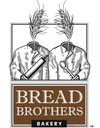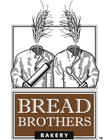Clean Food Care
At Bread Brothers, we talk about clean food a lot. It's one of the cornerstones of our business. Today we want to take a look at what it means to be clean, and share some tips for taking care of your clean food.
What is clean food?
Clean food removes artificial and highly processed ingredients, and replaces them with simple, natural ingredients your body was designed to be fed. It's a simple definition, but what does that mean in practice?
That means we avoid ingredients like BHA, BHT, nitrites, sulfites, benzoates, parabens, trans fat, bleached flour, bromated flour, high fructose corn syrup, artificial colors, artificial flavors, artificial sweeteners, and all imitation ingredients.
What's our alternative? Here's an example: we craft our sourdough from flour, water, and salt. That's it. No chemicals, no preservatives, and nothing that you can't pronounce or understand. Simply put, clean food (or real food as we also like to call it) is just made from “normal” ingredients.
Storing Clean Food: 1 Day to 1 Week
There are almost innumerable health benefits that come from replacing processed foods with clean options, but today we want to focus on how to care for clean food. Taking care of your food isn't a high maintenance activity, but it's important to store your food properly.
If there's one thing you should remember about storing your food, it's that clean food doesn't last forever! A loaf of bread from the grocery store can sit out on the counter for weeks on end and still be edible, but frankly that's unnatural and unhealthy. It may be a hard truth to swallow, but most food isn't supposed to last that long.
Artificial preservatives may do wonders for shelf life, but real food is intended to be eaten within a few days. After buying or baking a loaf of clean bread (or other clean baked goods), you usually have about 1-2 days before the food begins to turn stale or moldy. They may last longer or shorter, but we wouldn't expect anything more than 2 days.
Of course, this isn't a huge problem if you plan on eating something in 1 or 2 days. If you need longer than that, you can keep your baked goods in the fridge. They'll reliably last for about a week.
A note on storing pie and cobbler: whether placed on the counter for same-day enjoyment or kept in the fridge for several days, pie and cobbler should be stored outside the cardboard box. The box will trap enough moisture to turn the crust soggy and the fruit runny. We only place these items in boxes once a customer arrives to pick them up, and we recommend removing pies and cobblers from their cardboard as soon as you get home.
We also warn that pie and cobbler change considerably once frozen and thawed, due to the expansion of water in frozen fruit. They are safe to freeze, but the texture will be different when eaten. For this reason, we never sell pies or cobblers that have been frozen.
Storing Clean Food: Longer Than 1 Week
But let's say you want something to last longer than a week. What do you do? You freeze it. The freezer has an unfortunate reputation as a ruiner of foods, but it's your friend. The freezer is a tool, and if you use it properly, it'll help keep your foods tasty for months.
Let's first address the two issues that lead people to distrust the freezer. First is freezer burn. Foods get damaged in the freezer when they aren't properly packaged. It can be as simple as a Ziploc bag or an airtight Tupperware, just make sure your food isn't exposed. We recommend double layers just to be on the safe side - we always do the “bag in a bag” with our frozen goods.
The second issue is longevity. People tend to assume frozen food lasts forever. Frozen baked goods will remain very tasty for 2-3 months. They'll remain edible longer than that, but if you leave them in there for six months or a year, you may start to notice they become mushy or stale when thawed.
That's enough doom and gloom, let's talk about the right way to freeze. If there's one thing you should remember, it's FREEZE FRESH! Something that's frozen right after being baked will still taste freshly baked when thawed and eaten later. The sooner you freeze something after it's baked, the fresher it will taste later on.
Having said that, there are different “strategies” for freezing something like a loaf of bread. You could keep one half on the counter or in the fridge and put the other half in the freezer. One technique we like to use is the “daily slice method”. You can slice a fresh loaf of bread, freeze the whole thing immediately, then pull out slices as needed for that fresh baked taste every time. Accidentally froze a loaf before slicing it? You can thaw it just enough to slice, then safely return it to the freezer.
Why We Freeze
If you pick up an order from us and it's frozen, fear not! We freeze things fresh to help them last longer for you. Everything you get from us was baked to order. We don't stockpile baked goods in our freezers or sell old food to our customers.
Thawing and Reheating Frozen Goods
Orders that are picked up frozen should remain frozen until the day you intend to eat them. Once you are ready to eat, we recommend one of the following three courses of action, depending on the item:
- Baked goods that do not have any icing or frosting should first be thawed on a countertop for 1-2 hours. Once thawed, loosely wrap items in foil, place on a cookie sheet or directly on your oven rack, and warm for 10-15 minutes.
- Items that are frosted or iced should be placed on a countertop to thaw for 1-2 hours, after which they can be served and eaten.
- Items that are frosted or iced that you wish to eat hot can be warmed in the microwave, either before or after thawing.
Wrapping items in foil before warming in the oven prevents them from drying out. Thawing items in their bag has a similar effect, and this can be used strategically. For example, thawing cupcakes in the bag helps keep the cake moist. On the other hand, thawing pretzels out of the bag helps keep the outside chewy and prevents them from turning soggy. Items can be thawed in or out of their plastic bags according to personal preference.
It should also be noted that some smaller items, such as pretzels and croissants, can be microwaved directly from the freezer for rapid thawing and serving.





Leave a comment